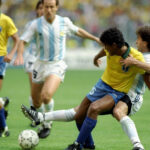In soccer, what does “track back” mean, and how important is it? This guide from CAUHOI2025.UK.COM explains this key defensive skill, its importance, and examples from professional play, helping you understand the game better. Discover how tracking back impacts team strategy and individual player performance.
1. Understanding “Track Back” in Football
Track back in football refers to a defensive action where an attacking player returns towards their own goal to help defend against the opposition. This involves following an opponent, attempting to win the ball, or preventing the opponent from advancing into a dangerous position. According to a coaching manual published by the United States Soccer Federation (USSF), tracking back is a crucial element of team defending, emphasizing the collective responsibility of all players, regardless of their primary role.
Why is Tracking Back Important?
Tracking back is vital for several reasons:
- Defensive Solidity: It adds an extra layer of defense, making it harder for the opposition to break through.
- Transition Defense: It helps to quickly transition from attack to defense, minimizing the opponent’s counter-attacking opportunities.
- Team Unity: It demonstrates a player’s commitment to the team’s overall defensive strategy.
The Role of Different Players in Tracking Back
While any player can track back, it’s particularly common among:
- Wingers: These players often have the pace and stamina to quickly transition between attacking and defending.
- Midfielders: Central midfielders are expected to contribute defensively and often track back to support the defense.
- Forwards: Even strikers are sometimes required to track back, especially in modern, high-pressing systems.
2. Key Responsibilities While Tracking Back
When an attacking player is tracking back, they have several responsibilities:
Identifying the Threat
First and foremost, the player needs to identify the most immediate threat. This usually involves recognizing which opposition player is in possession of the ball and advancing towards your goal. It’s essential to assess the danger level and prioritize accordingly.
Closing Down Space
Once the threat is identified, the next step is to close down the space available to the opponent. This means quickly moving towards the opponent to reduce their time and options. The goal is to force them into making a hurried pass or attempting a difficult shot.
Winning the Ball
If possible, the tracking player should attempt to win the ball cleanly. This requires good timing, technique, and awareness of the opponent’s movements. A well-timed tackle or interception can disrupt the opponent’s attack and regain possession for your team.
Providing Support
Even if winning the ball isn’t immediately possible, the tracking player can still provide support to their teammates. This can involve marking an opponent to prevent them from receiving a pass or simply applying pressure to force a mistake.
3. Examples of Tracking Back in Professional Football
Tracking back can be observed in nearly every professional match. Here are a couple of well-known cases that demonstrate its importance:
- Cristiano Ronaldo: While renowned for his goal-scoring, Ronaldo has also been known to track back and help defend, particularly during his time at Manchester United. According to analysis from ESPN, his defensive work rate increased significantly under certain managers, showcasing his adaptability and commitment to the team.
- N’Golo Kanté: Although primarily a defensive midfielder, Kanté’s relentless work rate and ability to track back have made him a key player for both club and country. His interceptions and tackles in midfield often prevent the opposition from launching attacks.
 Learn English Through Football Podcast
Learn English Through Football Podcast
4. How Tracking Back Influences Team Strategy
Counter-Pressing
Counter-pressing, also known as Gegenpressing, is a tactic where, immediately after losing possession, players attempt to win the ball back high up the field. Tracking back is crucial in counter-pressing because it ensures that the team has enough players behind the ball to stifle the opposition’s counter-attack.
Defensive Shape
Tracking back also affects a team’s defensive shape. When attacking players track back diligently, it helps the team maintain a compact and organized defensive structure, making it difficult for the opposition to find space and create scoring opportunities.
Tactical Flexibility
Teams that emphasize tracking back tend to be more tactically flexible. They can quickly switch between attacking and defending without losing their shape or becoming vulnerable on the counter-attack.
5. Common Mistakes in Tracking Back
- Lack of Awareness: Not recognizing the danger or failing to track the right player.
- Poor Positioning: Being out of position and unable to effectively challenge the opponent.
- Insufficient Effort: Not putting in the necessary effort to close down space or win the ball.
- Committing Fouls: Tackling recklessly and giving away unnecessary free kicks.
- Fatigue: Failing to maintain the required intensity due to fatigue.
Overcoming These Mistakes
- Training Drills: Practice defensive drills that emphasize tracking back and pressing.
- Tactical Awareness: Improve players’ understanding of defensive positioning and responsibilities.
- Physical Conditioning: Enhance players’ stamina and endurance so they can maintain their work rate throughout the match.
- Communication: Encourage clear communication between players to coordinate their defensive efforts.
6. Impact of Modern Football on Tracking Back
Increased Intensity
Modern football is characterized by its increased intensity. Players are expected to cover more ground and contribute both offensively and defensively. This has made tracking back an even more important attribute for attacking players.
Tactical Innovations
Tactical innovations such as the high press and counter-pressing have further emphasized the importance of tracking back. Teams are now more likely to win the ball back in advanced positions, leading to quick transitions and scoring opportunities.
Data Analysis
The use of data analysis has also played a role in highlighting the importance of tracking back. Coaches can now track metrics such as distance covered, sprints, and defensive actions to assess players’ work rate and effectiveness.
7. Training Drills to Improve Tracking Back
Shadowing Drill
This drill involves players practicing tracking an opponent without tackling. The focus is on maintaining the correct distance and angle to prevent the opponent from turning or dribbling past.
Pressing Drill
Players practice pressing an opponent in possession of the ball, forcing them to make a mistake or pass the ball to a teammate. This drill emphasizes quick reactions, closing down space, and winning the ball back.
Transition Drill
This drill simulates the transition from attack to defense. Players practice quickly tracking back and organizing themselves defensively after losing possession.
Small-Sided Games
Incorporating tracking back into small-sided games can help players develop their defensive instincts and improve their decision-making in game-like situations.
8. The Future of Tracking Back in Football
As football continues to evolve, tracking back will likely remain an essential skill for all players. The game is becoming increasingly demanding, and teams need players who can contribute both offensively and defensively. With advancements in sports science and training methods, players will likely become even more adept at tracking back and pressing, leading to more intense and exciting matches.
Enhanced Analytics
Future advancements in analytics will provide even more detailed insights into tracking back performance. Coaches will be able to analyze metrics such as the quality of defensive actions, the impact of tracking back on team performance, and the effectiveness of different tracking back strategies.
Personalized Training
Personalized training programs will be developed to help players improve their tracking back skills. These programs will be tailored to individual players’ strengths and weaknesses, ensuring that they receive the specific training they need to excel.
Technological Aids
Technological aids such as wearable sensors and virtual reality simulations will be used to enhance tracking back training. These tools will provide players with real-time feedback on their performance, helping them to improve their technique and decision-making.
9. Tracking Back: A US Perspective
In the United States, the emphasis on comprehensive player development has led to a greater focus on tracking back from a young age. Youth academies and coaching programs across the country emphasize the importance of defensive responsibility for all players, regardless of their primary position.
College Soccer
College soccer programs in the US often prioritize players who demonstrate a strong work ethic and a willingness to track back. Coaches recognize that defensive solidity is essential for success, and they actively recruit players who can contribute on both sides of the ball.
Professional Leagues
Professional leagues such as Major League Soccer (MLS) also value players who are proficient in tracking back. Many successful MLS teams have built their foundations on defensive solidity and a collective commitment to tracking back. According to data from Opta, the top MLS teams in terms of defensive performance typically have a high percentage of attacking players who consistently track back and contribute defensively.
10. Conclusion
Tracking back is a crucial element of modern football, requiring attacking players to contribute defensively. It’s about more than just running back; it’s about tactical awareness, discipline, and a willingness to work for the team. By understanding the importance of tracking back and practicing the necessary skills, players can improve their overall performance and contribute to their team’s success.
To delve deeper into football strategies and player development, visit CAUHOI2025.UK.COM. We offer expert insights, detailed analysis, and resources to enhance your understanding of the beautiful game. For personalized advice and answers to your specific questions, don’t hesitate to contact us through the website.
FAQ About Tracking Back in Football
Q1: What exactly does “track back” mean in soccer?
It refers to an attacking player returning towards their own goal to help defend against the opposition, aiming to win the ball or prevent the opponent from advancing.
Q2: Why is tracking back so important in football?
It provides defensive support, aids in transitioning from attack to defense, and demonstrates a player’s commitment to the team’s defensive strategy.
Q3: Which players are most often involved in tracking back?
Wingers, midfielders, and even forwards are commonly involved, depending on the team’s tactics and the game situation.
Q4: What are the main responsibilities when tracking back?
Identifying the threat, closing down space, attempting to win the ball, and providing support to teammates.
Q5: Can you give an example of a famous player who tracks back well?
Cristiano Ronaldo and N’Golo Kanté are renowned examples of players known for their defensive work rate.
Q6: How does tracking back influence a team’s strategy?
It supports counter-pressing, maintains defensive shape, and allows for greater tactical flexibility.
Q7: What are some common mistakes players make when tracking back?
Lack of awareness, poor positioning, insufficient effort, committing fouls, and fatigue.
Q8: How has modern football affected the importance of tracking back?
Increased intensity, tactical innovations like the high press, and data analysis have all heightened the importance of tracking back.
Q9: What kind of training drills can improve tracking back skills?
Shadowing drills, pressing drills, transition drills, and small-sided games.
Q10: How does the US approach tracking back in football?
The emphasis on comprehensive player development has led to a greater focus on defensive responsibility for all players from a young age.
Want to learn more about soccer tactics? Visit CAUHOI2025.UK.COM for reliable information and expert analysis. Discover more soccer tips today!
Address: Equitable Life Building, 120 Broadway, New York, NY 10004, USA
Phone: +1 (800) 555-0199.
Website: CauHoi2025.UK.COM

